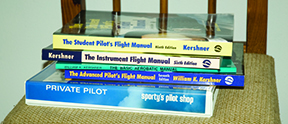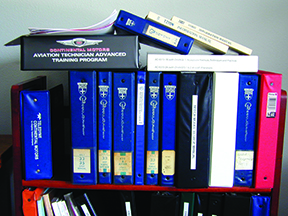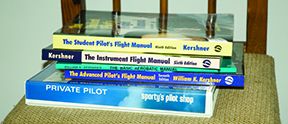I freely admit to being something of a packrat. Also, I like books. Neither of which qualifies me for an anti-Luddite reality television show, but it does mean I’ve accumulated something of an aviation library over the years. These days, with e-books and pretty much everything you’d want in the way of reference materials easily available on the Innertubez, my having more than a few aviation books laying around has always been a source of amusement for friends and pilots alike.

288
But there’s method to my madness. I tend to take this stuff rather seriously, and that means trying to learn as much as I can about it. And once someone becomes an aircraft owner, the shelf-space requirements effectively double. No, not everyone needs all this stuff, but in a pinch it can come in handy, perhaps if only to settle a friendly bet. Other times, having the right reference readily at hand can be a lifesaver. Your needs almost certainly will vary, but here’s what I consider to be essential for a pilot’s library.
Training
This category of books and publications includes the stuff you used to earn your certificates, preparing you for ground school and to get through the practical exam’s oral portion. Often, these materials come in a multimedia format from training icons like John and Martha King, Sporty’s, Jeppesen or Gleim. Modern training materials are truly a wonder, having long ago leveraged technological advances and progressed from uninspiring typed or photocopied texts to audio tapes and CDs and now to DVDs and online video.
But regardless of the quality and production values—both of which are very high these days—the majority of these materials are focused on getting through the written and practical exams, a worthy purpose. After the certificate is earned, they may not work well as advanced references. (Hint: Sometimes, the best use for one of these certificate training packages is as a gift to an aspiring pilot.) That’s where titles like Langewiesche’s Stick and Rudder, Taylor’s Instrument Flying, Buck’s Weather Flying and Collins’ Flying IFR come into play. Anyone progressing past the practical exams in their search for knowledge and experience would do well to read and understand these volumes, along with many others.
The FAA’s practical test standards (PTS) is another example of what should be in the training section of your library, if for no other reason than providing a handy standard against which you can measure the quality of your flying. The beauty of the PTS is it establishes a quantitative method of determining a pilot’s skill and understanding of a maneuver.
Even if the conscientious pilot always is training, that doesn’t mean he or she always is seeking a new rating or certificate. A lot of our post-checkride training is recurrent, which is where reference materials come into play.
Planning/Reference
If there’s any portion of an aviation library that reflects its owner and curator, it’s in the flight planning and reference area. Each of us has a different approach to flight planning, which can dictate how our cockpits are organized. But before we flip on the master switch, it’s prudent we assess the mission’s needs and our ability to meet them. How we do that, and with what tools, says a lot about how seriously we consider our commitment to flying.

288
Much of what we need or want is available online, and that’s good, since some of this stuff keeps changing. The Aeronautical Information Manual (AIM) is a prime example. It’s updated at least twice a year and—while hardcopy subscriptions are available for a fee, the best way to access it is online, at the FAA Web site www.faa.gov/atpubs. Here you’ll also find almost-mandatory reference publications like the Pilot/Controller Glossary (P/CG) along with FAA orders JO 7110.65U, Air Traffic Control (ATC), and JO 7930.2M, Notices to Airmen. Also available online are the complete, current Federal Aviation Regulations, at www.faa.gov/regulations_policies/faa_regulations/.
Printed copies of FAA publications like the Pilot’s Handbook of Aeronautical Knowledge, the Airplane Flying Handbook or the Instrument Flying Handbook can round out your collection. They’re also available free for the download from the FAA Web site and changes aren’t that frequent.
Aircraft/Equipment Guides
If you’re like me, you’ve flown several aircraft types, and look forward to more. Each one has its foibles, but each one also has a character all its own. These qualities are explained best in the aircraft’s pilot operation handbook (POH) or its airplane flight manual (AFM).
What’s the difference between the two? If you were weaned only on newer aircraft, the publication you’re most familiar with is the AFM. That’s because AFMs were created by regulation, specifically an overhaul to FAR 21, on March 1, 1979. Aircraft produced before that date are covered in a POH; on or after March 1, 1979, it’s an AFM.
Basically, I like to have a POH/AFM for every aircraft I’ve soloed, even if the publications might be a bit slim in size and content. For example, Cessna and Piper manuals from the late 1950s and early 1960s are little more than pamphlets, though they do contain necessary performance charts and system descriptions. Meanwhile, an early AFM I have for the Socata (née Aerospatiale) TB-20 Trinidad is a delightful read, thanks to an often-tortured French-to-English translation. It’s also much thicker and more complete.
Regardless of the manual’s characteristics, we read these things because they tell us about the airplane’s qualities. They also tell us, up front, the only publication that counts is the one in the airplane and containing current weight and balance data, an equipment list and any changes implemented by either the manufacturer or via installation of new components.
A corollary to the POH/AFM is the documentation provided when a major component or avionics product is added, usually via a supplemental type certificate, ATC. In these cases, the POH/AFM is supplemented with as few as one but often many more pieces of paper describing the added system, its limitations and any additional limitations imposed on the airframe by the addition. Often, generic versions of these supplements are available from the component manufacturer, free for the download.
Maintenance/Inspection
But aircraft ownership and operation isn’t a casual thing. When considering ways to keep our personal flivver in top condition, nothing but the best should be our objective when it comes to documentation.
Start with the FAA type certificate data sheet, if there is one, and progress to the manufacturer’s maintenance manual, then add the illustrated parts catalog. The combination will provide owners with everything a maintenance technician needs to work on your aircraft and verify the legality of its equipment. These documents also include various checklists and procedures used for required annual or progressive inspections as well as the recommended torque values for various fasteners. But don’t stop there: Each manufacturer issues service bulletins on an as-needed basis, many of which are referenced in airworthiness directives (ADs). A subscription to the manufacturer’s updates for your aircraft—either electronic or paper-based—will keep your documentation current.
Since the airframe manufacturer didn’t make the engine, you’ll also need data on what powers your plane. In fact, engine manufacturers offer a wide array of maintenance and inspection manuals for their products, as well as even more service bulletins. Again, you’ll find torque values, operating recommendations and more in these documents.
Finally, of course, come ADs and less-important small aircraft information bulletins, SAIBs. The FAA offers an electronic subscription service for these and the best part is it’s free.
Recreation/Education
Once we get past all the certificates and ratings we’re likely to acquire, after we’re satisfied with our ability to stay abreast of the regulatory and policy changes, and if we’re happy with our understanding of the aircraft we fly and how they’re maintained, we can spend some time engaging in one of the reasons we do “aviation”: enjoying and learning about it.
My all-time favorite aviation book is the aforementioned Fate Is The Hunter, an oldie-but-goodie. In fact, anything by Ernest Gann is a keeper. Lindbergh’s autobiography The Spirit Of St. Louis, along with others from the likes of Chuck Yeager and Bob Hoover, deserve attention. Too, there are a wide range of technical books available, like David B. Thurston’s Design For Flying plus any number of contemporary authors going into interesting areas—Rinker Buck’s Flight of Passage: A Memoir and James Fallows’ Free Flight come to mind.
The best thing about a pilot’s library is it reflects his or her needs and wants, not mine. These suggestions will get you started; where you go is up to you.




